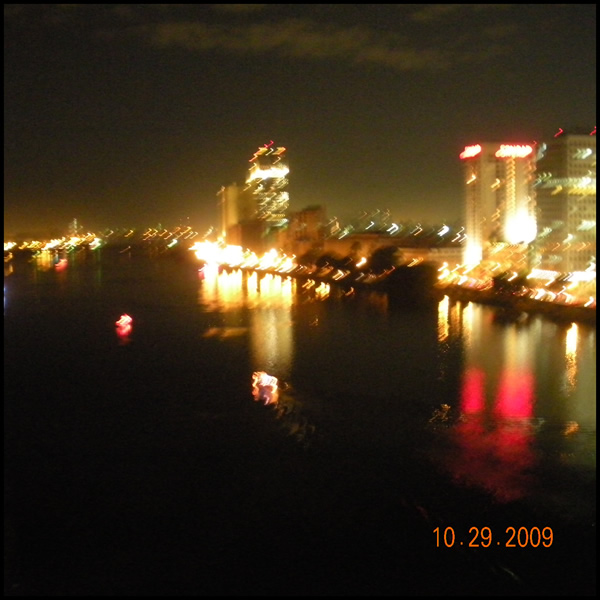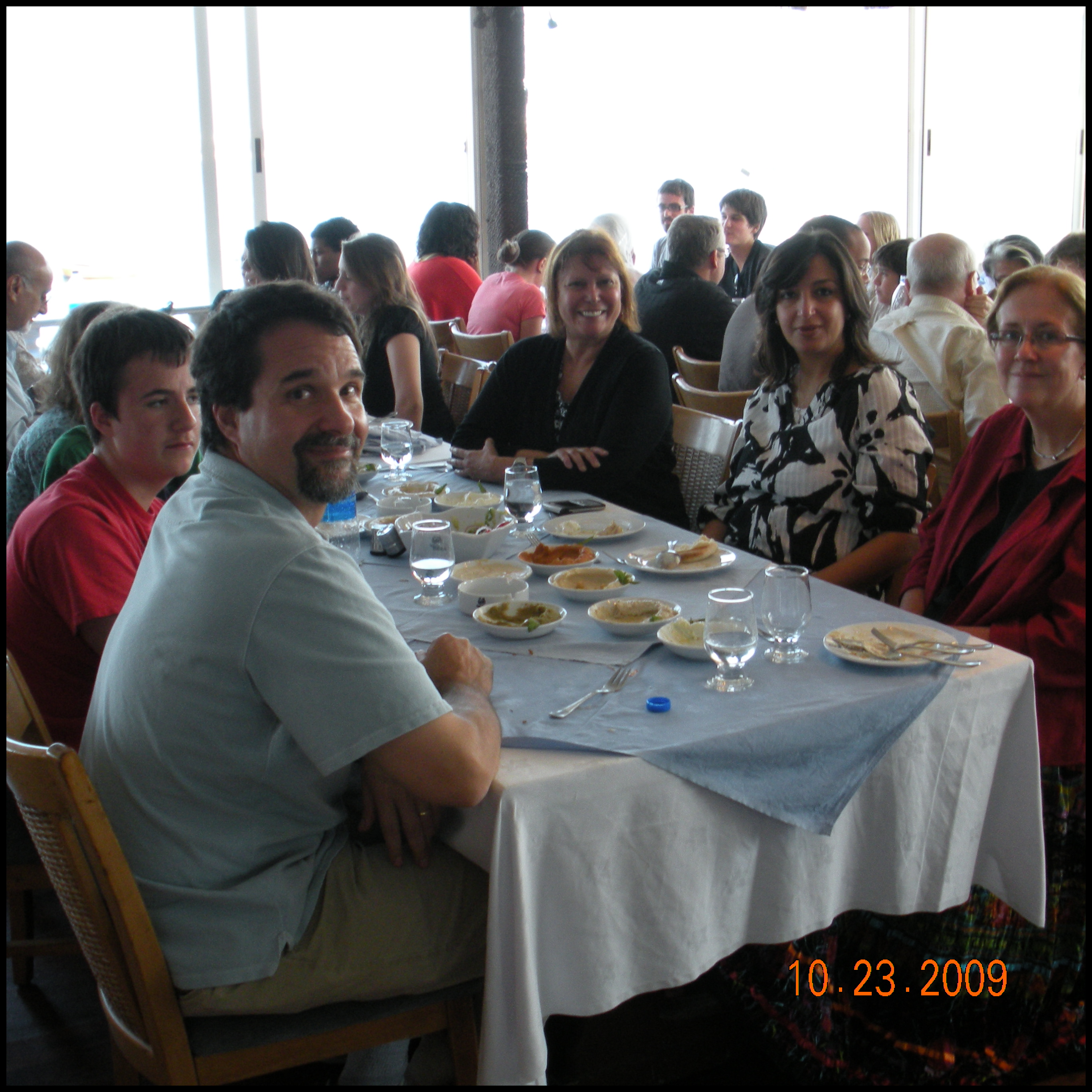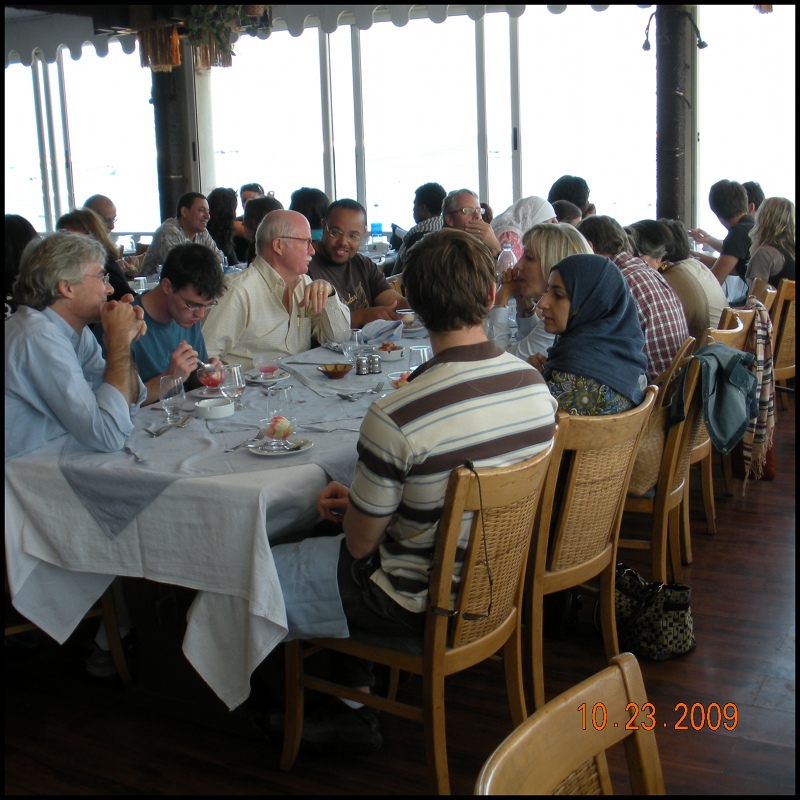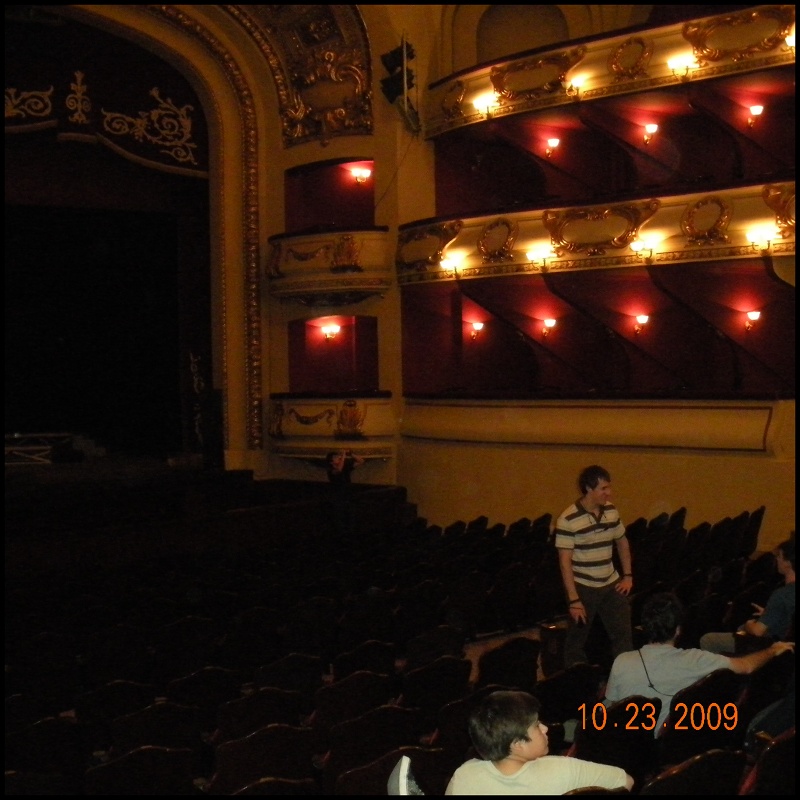This post is part of a series of posts documenting my trip to Egypt. To read from the beginning, go to the
first post and follow the links at the bottom of each page.
Sunday 1 November 2009
Friday morning, over a breakfast of pancakes with Karl, Katy and the kids, we planned out the day; I wanted to get out of their way because it was their weekend; the kids had things going on and Kate had to prepare a lecture she was to give on Saturday morning at the university. It was now eleven o’clock and Karl and Kate had arranged for me to accompany them to an outdoor Blues concert at the pyramids that evening. It started at four and I had to be back by three in order to meet the car that would take us out there. It was going to make for a tight schedule; if I didn’t get moving, I wouldn’t have time to examine the pieces in the collection at the museum I wanted to visit.
Of the three museums I wanted to visit, one—the Islamic Museum—had been closed for renovation and had not yet re-opened, so that was out. I really wanted to see the Gayer-Anderson Museum which the guide book said was open on Friday, but closed during the noon prayer. I grabbed a cab and headed in that direction, hoping to get there before it closed. Since it was Friday, the traffic was very light and even though I had a rookie cabbie, we found the location in fairly short order. However, when we pulled up outside the Ibn Tulun Mosque, which abuts the museum, a young man came to the driver’s window and said that the museum was closed for an hour. It was apparently time for the noon prayer.
That being the case I asked the driver to take me to the Egyptian Museum, which I KNEW was open and, even though there were no block prints for me to look at there, there was plenty of other stuff to look at for a couple of hours. He dropped me at the corner across from the museum and, as I exited the cab and ran to the median of the street, it began to rain.
Suddenly, a guy appears at my shoulder and asks me where I was going.
“Al-Mat-haf,” I responded, pointing across the street. The museum.
“Oh” he says, “is closed for prayers. Doesn’t open for one hour.” The lawn in front of the building was filled with people sitting on the edges of flower beds and wandering around the grounds. It looked to be true.
I thought, “Great.” And it’s starting to rain harder.
“I’m so happy today,” says the guy still standing next to me. “My daughter is getting married tomorrow. I’m so happy. I have a gift for you. Come to my shop. It is here. Come.”
Well, I’m not keen on getting wet so I follow him, already knowing this is probably not a good idea. He guides me around knots of men praying on the sidewalk, cautioning me not to step on the mats laid down on the pavement as prayer rugs. (Many of the mosques are filled to overflowing at noon on Fridays, so men slap their prayer mats down on the sidewalks outside the mosques, or just near one, and pray “al fresco.”) We enter a darkened shop lined with glass cases containing an assortment of glass vessels, perfume bottles in all shapes and sizes. Upholstered wooden furniture, a wooden desk, a couple of chairs with spindle backs, and a settee along one wall gave the space the look of a library in an eighteenth century English country estate—Bleak House with an unmotivated staff.
“I’m so happy. My daughter is getting married tomorrow. Come, sit.” Flipping on low wattage lights he motions me to sit on the settee. I’m looking around, trying to get my bearings.
“Sit here; please sit.” So I do.
“You would like to drink something.” A question in the form of a declarative sentence. “Tea? Coffee? I have a gift for you!”
“La, shukran,” I finally say. No thanks.
“No. Please, you must drink something. Tea. Yes? Okay? Ya, Waad! Shay`!” (“Hey, boy! Tea!”) The order is placed before I can protest. “I’m so happy! Where are you from?” The tea is already at my elbow.
“Iowa.”
“Aywa?” A puzzled look. “Aywa” is the colloquial Arabic word for “yes.”
“La.” I shake my head. “No. Eye-Oh-Wah.” I enunciate each syllable as clearly as I can. “A state smack dab in the middle of the country.”
“Ah. I never hear of this.” A customer appears from another room and leaves the shop. That’s the signal for a new activity, apparently.
“Come,” says my new best bud. “I want to show you something. I’m so happy. My daughter getting married tomorrow! I have a gift for you!” I’m beginning to get an uncomfortable itchy feeling on the back of my neck. He grabs my tea glass and heads into the room his customer has just vacated.
Through a doorway, we enter a second room decorated much like the first. There behind a desk in a similarly appointed room is my friend’s, uh, accomplice.
“Ah,” says the partner, “come, sit here. Your tea is good?”
“Fine, thanks.” My friend retreats to a bench in the background.
“You know what we do here?” I look around. This room contains more wooden shelves with glass doors on them, but these cabinets are filled with larger bottles containing liquids of various colors. I feel like Harry Potter in Severus Snape’s first potions class, although I realize that this is much more innocuous. At least I hope so…
“We sell essential oils here. All these jars are oils we press from flowers. What kind of flowers do you like? Here, this is lotus.” The second guy takes a large bottle off the shelf next to him. The liquid in it is pale green. “You see the pictures of the lotus flowers on the walls? This flower grows only in Egypt. Very special. Here, you try it.” He pulls out the stopper, and I lean over to sniff it.
“No, no,” he protests. “Like this,” and he smears some on my wrist.
Okay, now I’m recalling the days when customers were assaulted by perfume spritzers as they walked through the cosmetics section of Lord & Taylor or Saks or numerous other department stores that employed young women to ambush them with clouds of mist as they passed by. The fragrance isn’t bad, actually, but what would I do with it? I apparently don’t look enthused.
“What about this one?” He grabs another bottle, uncorks it and smears another dab on my arm. I smell. Whoa! Way too heavy. Funeral home heavy. I tell him so. In Arabic. He looks hurt.
“Here,” he says, grabbing a third bottle and popping the plastic stopper. “This is jasmine. Not heavy, very ‘khafeef’ (light)” A drop smeared on the back of my other wrist and rubbed in vigorously. “You like this? Is very good. Calvin Klein, Gucci, Ralph Lauren, they all use these oil, but they mix with water, alcohol.” He wrinkles his nose and shakes his head. “Is not as good. This much better.” (Karl Lorenz later confirmed that this much was true. He was told as much by an Egyptian he knows well who makes purchases of these oils on a regular basis.)
I figure, it’s a gift so what the hey. “The lotus is nice, I guess.” With three very strong scents on my arm, it’s hard to tell what’s what by now.
”How much you want?” says desk guy. He pulls an assortment of bottles out of the cupboard next to him: a small brown one with gold stripes around it: “Two Hundred grams,” he says; a slightly larger one, clear with no decoration, “Five hundred grams;” another green one, “One thousand grams;” and finally a very large frosted white glass container, “Two thousand grams. Texas size.” A greasy smile.
“No thanks. Way too much.” The itchy feeling at the back of my neck has now spread across my shoulders and down my arms. A rash isn’t far behind. No way I’m being “given” that much stuff. “The small one is fine,” I say. “You did day this was a gift, right?” Desk guy gives no answer. Ahh. The light finally goes on.
“Okay. Small one. Two hundred grams lotus flower. Very nice.” He pops the cork on the lotus, fills the bottle, caps it with a plastic plug and seals it with a piece of cellophane tape. He then points to a sign on the wall behind him. It reads: 2 LE (Egyptian Pounds) per gram. “That will be four hundred Guinea, please.”(“Guinea” is actually the ‘official’ name of Egypt’s currency; it appears on the bills) He looks pleased with himself. Eighty bucks American!
But I’m not biting (finally). “No,” I say in Arabic, just so my meaning isn’t lost on them. “That is more oil than I or any two people could use in a lifetime. I don’t want that much.” Damned if I’m going to spend $80 on something that might go rancid before half of it is used. An awkward moment of silence follows. It’s clear now what the deal is: the accomplice has made no promise of a gift, so he’s quite justified in asking for money. My buddy is just sitting there; it’s no longer his deal.
“I’ll take half that amount and no more.” My tea is gone and it’s left a bad taste in my mouth. A third guy, somewhat younger than the other two, has joined us at some point and, when desk guy hesitates, he takes matters into his own hands, telling desk guy to empty out half the bottle and close the sale. Desk guy is a bit flummoxed and Number Three has to do it for him. The bottle is wrapped in paper and I fork over my 200 pounds. Okay, I’m a tourist and I’m probably being way overcharged but I’m sort of impressed with the scam. It’s actually pretty slick. I rise and pick up my overpriced lubricant, prepared to leave.
But my bud has other ideas. He leaps back into action. “I want to show you something else, very special. Come this way.” Down a short corridor toward the back of the shop, more lights are turned on and we’re in a room whose walls are covered with paintings on what my friend says is papyrus. “Ten pounds only,” he crows. “Which one you like?”
Now, I had been warned about this business. Every tourist who comes to Egypt knows that this is the land of papyrus and assumes that it’s readily available and cheap. But they underestimate the ingenuity of the Egyptians. Some clever ones have discovered, for example, that you can make something that LOOKS LIKE papyrus, but is made from banana palm leaves, not the papyrus plant. That stuff will curl and turn yellow before you get it home. Some of the pieces I’m being shown have a label stating that the item is “genuine,” but the art work is crappy tourist stuff, with paintings (more likely four color prints) of generic ancient Egyptian figures in profile. Definitely no.
“No, thanks. Not interested.”
“What about this one? This is very nice.”
“No. We’ve finished our business. Goodbye.”
“Oh, okay. Thank you for coming.”
I turn and head for the door. Someday I’ll learn. Someday.
It turns out that the Egyptian Museum wasn’t even closed for the noon prayer. There are too many tourists wanting to see the collections for the government to inconvenience people who want to give them money. The courtyard was full simply because there were so many people visiting that day. I go through the security gate, where I have to explain the bottle in my pocket. The cop wants to scan it but his partner asks me what it is. “Attar,” I say. “Perfume.”
The cop looks at me and smiles a knowing smile. “Ahh! Perfume. Never mind, please proceed. Have a nice visit.” I’m sure the two cops were nudging each other in the ribs behind my back. “There goes another sucker…” Snicker, snicker.
I spend about three hours in the museum, one of Egypt’s largest and most important. The building was erected between 1897 and 1903, at the height of the period of archaeological activity in Egypt that uncovered Tutakhamen and all those other spectacular finds from ancient Egypt. It is a huge Victorian warehouse, essentially, with stuff, stuff and more stuff. Imagine your crazy aunt’s attic. More sarcophagi than you can shake a stick at, statues of pharaohs all over the place, metal artifacts, wooden artifacts (including a boat meant to carry the soul of one pharaoh on his afterlife journey), pottery and who knows what else. It’s dusty, mostly unlabeled and not well organized at all. But the amount of objects and artifacts is overwhelming. Room after room of things. I didn’t even go through the “Royal Mummies” exhibit; there was an additional charge for that and I had blown my budget on lotus oil.
People wearing id badges would come up every so often and ask if I wanted a guide. I saw lots of tourist groups taking advantage of these services and I overheard a variety of languages—French, German, Italian—being spoken by them so my guess is that the guides were bona fide, probably university students, or maybe even teachers or professors, picking up a few extra bucks on the weekend. I can’t vouch for the accuracy of the information they were conveying, however, and I didn’t engage anyone. The museum was packed with tourists and they continued to stream in, the space inside getting more and more crowded, as I wandered through the various rooms. I’ve heard that the Minister of Antiquities, Zahi Hawwas, is planning to build a new multi-million dollar museum out near the Pyramids to replace this pile. Anything would be an improvement over this; the building has obviously outlived its usefulness.
When I had had my fill of ancient Egyptian and Greco-Roman antiquities, I wandered back outside and got a cab back to Zamalek. I didn’t want to be late for the transport out to the concert that evening. The cab ride was quick since Friday was a weekend and traffic was light. Arriving on Karl and Katy’s street with plenty of time to spare, I stopped in the Beano Café landmark and ordered a light lunch. This was the first time I had treated myself to a restaurant meal in some time and the first real coffee—a cappuccino—that I had had in several weeks. I finished my sandwich and lingered over the coffee. Just before 3 PM, I called Karl and asked if it would be convenient for me to come to the apartment now. He said it would be okay so I made my way there.
Ginger da Costa came up from her apartment shortly after I arrived and together we trooped over to the apartment building of a friend of Ginger’s, another Kathy, who had arranged for the van to carry us to the pyramids. We were joined by Belle Gironda who, like the second Kathy, is teaching at AUC. We all piled into the van and made the forty-five minute drive out to the pyramids in Giza. The area had changed dramatically since I was there thirty years ago. Residential and commercial properties had expanded so that they were really quite close to the pyramids and the Sphinx. The preserved area around the monuments was surrounded by walls and a fence, enclosing a very large area. Thirty years ago, this was the edge of the desert. We walked through the gates and onto a large paved plaza where rows of folding chairs had been set up.

The stage was erected in such a way that the pyramids provided a dramatic backdrop for the musicians. A brief light shower caught us by surprise and I thought we might be forced to retreat to a nearby shelter, but the rain quickly ended and the sun started to slip toward the horizon behind the pyramids. A few scattered clouds in the west glowed peach and pink.

Soon after we took our seats, the band was introduced and began to play. Bluzapalooza, as I later learned the group was called, included Zac Harmon, Deanne Bogart, and Terry ‘Harmonica’ Bean. Steve Simon (a musician and concert promoter from St. John’s, Virgin Islands) had apparently arranged the event in consultation with the American Ambassador to Egypt, who is a blues fan herself. The group played for a little more than an hour, exciting the mostly young Egyptian crowd, many of whom stood in front of the stage or danced to the music in the aisles. There was a sizable group of adolescent women, most in some form of hijab, among the revelers and it was interesting to see that they stood to the side as the boys took to the dance floor. Obviously young women do not boogie in public here. That didn’t stop the American women in the audience.
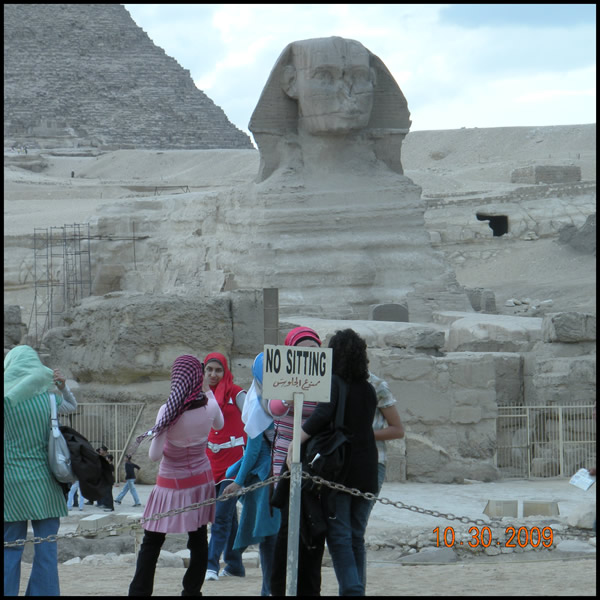
Ginger and Belle, among others, were in the thick of the arm waving, swaying and stomping. I was struck by the cultural incongruities of African American musicians playing African inspired music in front of ancient Egyptian funerary architecture. I wondered what the pharaohs would have made of this.
The band was good. Tight and practiced. They obviously enjoyed playing together and were inspired by the venue. They performed a lot of blues standards as well as covering some crossover tunes, like Bob Marley’s “No Woman, No Cry.” After about an hour, they cranked out one encore, thanked the audience and turned off the amps.
We made our way to the exit, found our van and rode back to the apartment. Karl and Katy ordered food over the internet from a service called “Otlob,” which is a transliteration of the Arabic word for “order.” We enjoyed a nice meal around the table and then crawled off to bed. Tomorrow I’m off to the Fayyoum to see an archaeological dig.
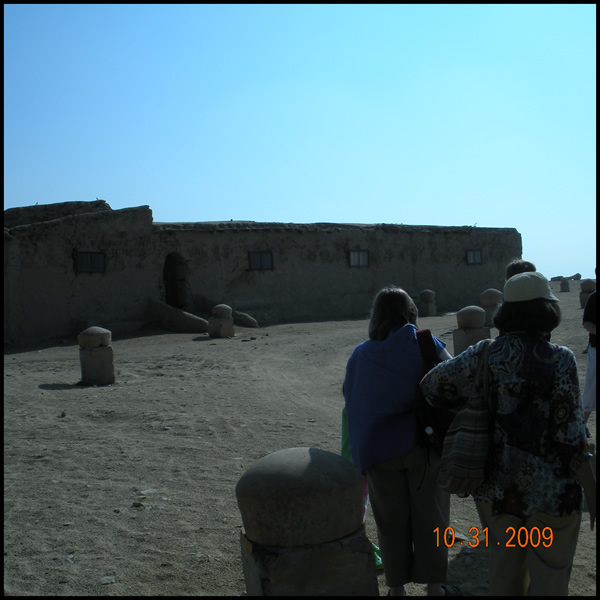 Dr. Wendrich has been excavating at Karanis for three years and her work follows on work done by a team of archaeologists from the University of Michigan that worked here in the 1930’s. The “dig house” that the University of Michigan team had had built was our first stop on the tour. It was constructed using the same mud brick technology that had been employed here forever and consequently had suffered the same fate as all mud brick. Without yearly maintenance, it had crumbled and dissolved in many places; the roofs had caved in and the walls had buckled. Dr. Wendrich had begun to renovate the building with the intention of turning it into a visitors’ center, complete with an observation deck on one roof. Of course all this takes money and progress is slow.
Dr. Wendrich has been excavating at Karanis for three years and her work follows on work done by a team of archaeologists from the University of Michigan that worked here in the 1930’s. The “dig house” that the University of Michigan team had had built was our first stop on the tour. It was constructed using the same mud brick technology that had been employed here forever and consequently had suffered the same fate as all mud brick. Without yearly maintenance, it had crumbled and dissolved in many places; the roofs had caved in and the walls had buckled. Dr. Wendrich had begun to renovate the building with the intention of turning it into a visitors’ center, complete with an observation deck on one roof. Of course all this takes money and progress is slow.

 The scale of this operation, and the effect on the site was astounding, even eighty years on. We walked to a rise and looked down into a bowl-shaped crater that easily covered several acres of ground. The mud brick and other refuse had been dug out to a depth of at least twenty or thirty feet and the unwanted chunks of masonry and stone rubble had simply been tossed aside in heaps. I asked Bethany at this point whether there were any Islamic ruins on the site and she said no; the site had apparently been abandoned before the arrival of the Arab armies in the seventh century and had not been settled after that. This was a disappointment but I was glad to have had the opportunity to see what sort of effect sebakh removal could have on an archaeological site.
The scale of this operation, and the effect on the site was astounding, even eighty years on. We walked to a rise and looked down into a bowl-shaped crater that easily covered several acres of ground. The mud brick and other refuse had been dug out to a depth of at least twenty or thirty feet and the unwanted chunks of masonry and stone rubble had simply been tossed aside in heaps. I asked Bethany at this point whether there were any Islamic ruins on the site and she said no; the site had apparently been abandoned before the arrival of the Arab armies in the seventh century and had not been settled after that. This was a disappointment but I was glad to have had the opportunity to see what sort of effect sebakh removal could have on an archaeological site. Our tour continued with visits to another smaller temple and several granaries. Granaries were quite numerous in Karanis and excavations of them had revealed an elaborate system of storage and methods of protecting and accounting for what grain belonged to which farmer or landlord. There was a sizable Roman garrison here, at one time, to guard the grain. Part of that building still stood, but like all the other mud brick structures, it was slowly dissolving. Bethany showed us photos taken of the same area by the University of Michigan archaeologists; looking at them, it was clear that many of the structures then extant were simply gone, having decayed due to the effects of wind driven sand and rain. Bethany said that standard practice at Karanis, now, was to re-bury all the excavations performed in a season. Sterile sand is brought in to fill excavation trenches and protect any discoveries from weather damage. If any site is to be excavated further in a subsequent digging season (about four months in length, from August through November), the sterile sand has to be removed first.
Our tour continued with visits to another smaller temple and several granaries. Granaries were quite numerous in Karanis and excavations of them had revealed an elaborate system of storage and methods of protecting and accounting for what grain belonged to which farmer or landlord. There was a sizable Roman garrison here, at one time, to guard the grain. Part of that building still stood, but like all the other mud brick structures, it was slowly dissolving. Bethany showed us photos taken of the same area by the University of Michigan archaeologists; looking at them, it was clear that many of the structures then extant were simply gone, having decayed due to the effects of wind driven sand and rain. Bethany said that standard practice at Karanis, now, was to re-bury all the excavations performed in a season. Sterile sand is brought in to fill excavation trenches and protect any discoveries from weather damage. If any site is to be excavated further in a subsequent digging season (about four months in length, from August through November), the sterile sand has to be removed first.


